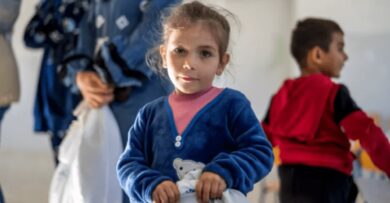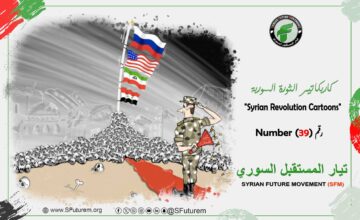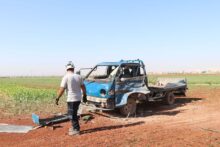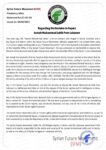Symbols and Figures of the State in Syria (10): Sultan Pasha Al-Atrash
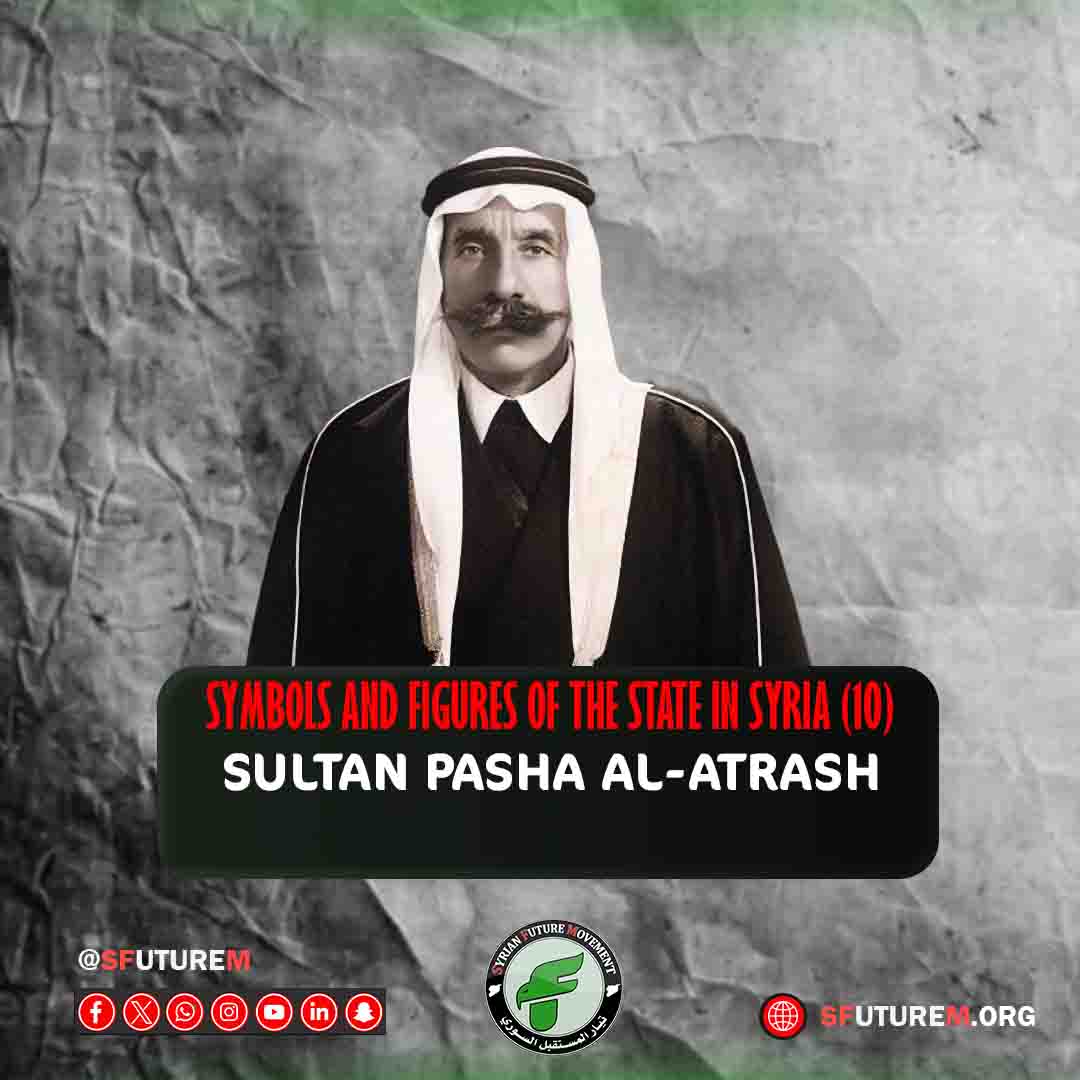
- Sultan Pasha al-Atrash was born in the village of al-Qurayya, in the Salkhad district of al-Suwayda province in the Levant in 1888 AD and passed away on March 26, 1982.
- From the renowned Druze family of al-Atrash, his father was Dhauqan bin Mustafa bin Ismail II, the founder of the Atrash sheikhdom in 1869, and his mother was Sheikha bint Ismail II.
- He was the eldest of his brothers Ali, Mustafa, and Zayd, and had two sisters, Sumayya and Na’eem.
- At the age of 19, he married his cousin, Fayez Ghaziya, but she passed away shortly after, leaving no children. After returning from mandatory service, he married Turkiya, the daughter of Sheikh Ibrahim Abu Fakhr from the town of Najran in Syria. Together they had all his male children: Talal, Fawaz, Yusuf, Jihad (all of whom passed away), Mansour, Nasser, and Talal. His daughters were Ghaziya, Butla, Zumurrud, Turkiya, Naifa, Aida, and Muntaha.
- He joined the Ottoman military and served in the Ottoman army in Anatolia, earning the title “Pasha” in recognition of his services in Eastern Europe (the Balkans). After his service, he returned to the Levant and began engaging with Arab nationalist movements.
- Due to his close ties with Damascus, al-Qurayya became a refuge and stronghold for revolutionaries who joined the Arab Revolt in Aqaba.
- He was the first to raise the flag of the Arab Revolt on Syrian soil before the entry of King Faisal’s army, hoisting it over his home in al-Qurayya. He was among the vanguard of the revolutionaries who entered Damascus in 1918.
- After raising the Arab flag in Marjeh Square over the government house in Damascus, King Faisal I awarded him the title of “Pasha” in 1918 in the Arab army for his bravery.
- Following the partition of the Middle East and the Levant into five federations, the French offered him governance over Jabal al-Druze in al-Suwayda as the prominent Druze leader of the time, but he resolutely refused.
- He supported the Arab-Islamic movement that sought to abolish the state of Greater Lebanon and establish an alternative Syrian Arab state, motivated by his belief in unity and rejection of division and colonialism.
- In July 1920, he prepared large forces to assist Yusuf al-Azma in Maysalun, but upon reaching Barak, south of Damascus, he received news of the battle’s outcome, the defeat of the Arab army, and the martyrdom of Defense Minister Yusuf al-Azma.
- He opposed the establishment of the Druze state in 1921 and fiercely resisted the French mandate before and after.
- He sent his comrades to join King Faisal I with a message inviting him to al-Suwayda—Jabal al-Arab to establish the Arab state and continue the resistance, but King Faisal’s reply was: “Tell Sultan, it’s too late.”
- Colonel Catroux, dispatched by General Gouraud to Jabal al-Arab, sought to isolate the Druze from the Syrian nationalist movement. On March 4, 1921, he signed a treaty with the Druze tribes, stipulating that Jabal al-Druze would form an independent administrative unit separate from the State of Damascus, with a local ruler and elected representative council, in exchange for Druze recognition of the French mandate. As a result of this treaty, Selim al-Atrash was appointed the first Druze ruler of the mountain.
- The people of the mountain were unhappy with the new French administration. The first clash occurred in July 1922 with the arrest of Adham Khanjar, who was on his way to meet Sultan al-Atrash with a message. The French arrested him, accusing him of participating in an attack on General Gouraud in Hauran.
- Sultan al-Atrash demanded from the French commander in al-Suwayda to hand over Adham Khanjar, but he was informed that Khanjar was on his way to Damascus. Al-Atrash then tasked a group of his supporters with attacking the armed convoy accompanying Khanjar, but the French managed to transfer him to Lebanon, where he was executed in Beirut on May 30, 1923.
- In retaliation for his attack on their forces, the French destroyed Sultan Pasha al-Atrash’s home in al-Qurayya in late August 1922.
- For an entire year, the Druze rebels, under al-Atrash’s leadership, waged guerrilla warfare against the French forces. The French brought in reinforcements to crush the rebels, forcing al-Atrash to seek refuge in Jordan by the end of the summer of 1922.
- Under British pressure, he surrendered to the French in April 1923 after negotiating a truce.
- Selim al-Atrash was poisoned in Damascus in 1924, and the French appointed Captain Carbillet as governor of the mountain, in violation of their agreement with the Druze.
- Due to Carbillet’s oppressive policies, the people of al-Suwayda staged a massive protest against the French authorities, accelerating the outbreak of the revolution.
- On June 6, 1925, a delegation from al-Suwayda traveled to Beirut to present a document to the High Commissioner Maurice Paul Sarrail, demanding the appointment of a Druze governor for the mountain instead of Captain Carbillet.
- Sarrail dismissed the delegation and refused to meet them, warning them to leave Beirut promptly or be exiled to Palmyra. This incident became the direct cause of the Syrian revolution.
- Sultan Pasha al-Atrash called for a meeting in al-Suwayda, where demonstrations spread across the mountain. He coordinated with several political leaders in Damascus, including Dr. Abdul Rahman Shahbandar, leader of the People’s Party, to consult and align their positions.
- Both sides agreed to cooperate in expelling the French from Syria and achieving independence and unity.
- Sultan al-Atrash declared that he sought to achieve his principles and program through lawful and legitimate means.
- On July 11, 1925, Sarrail sent a secret message to his representative in Damascus, asking him to summon some Druze leaders under the pretext of discussing their demands, with the intention of arresting and exiling them to Palmyra and Hasaka.
- Due to the French policies and practices, Sultan Pasha al-Atrash declared the revolution on July 21, 1925, by broadcasting a political and military statement calling on the Syrian people to rise up against the French mandate.
- In the statement, he said:
“O Syrian Arabs, remember your ancestors, your history, your martyrs, and your national honor. Remember that God is with the collective, and that the will of the people is the will of God. No civilized, rising nation will be touched by the hand of tyranny. The colonizers have looted our wealth, monopolized the benefits of our country, erected harmful barriers between our united homeland, divided us into peoples, sects, and small states, and prevented us from enjoying freedom of religion, thought, conscience, trade, and even travel within our own land. To arms, patriots, to arms for the realization of the nation’s aspirations, to arms in support of the people’s sovereignty and the freedom of the nation, to arms after the foreigner has stripped you of your rights, enslaved your land, broken your promises, and dishonored the official commitments, ignoring national aspirations.” - Al-Atrash began launching military attacks on the French forces and set fire to the French commission in Salkhad, the second-largest city in the mountain after al-Suwayda, and took control of it.
- In early September 1925, al-Atrash attacked a French force in the town of al-Kafr, led by Captain Norman, and his men decimated them. Only a few French soldiers survived. The number of rebels did not exceed two hundred, while the French troops numbered more than two hundred and sixty, including many French officers.
- Sarrail was enraged by the defeat and ordered the preparation of a large campaign to discipline the rebels, numbering more than five thousand soldiers.
- The French forces were decimated, with only about 1,200 soldiers managing to escape to the railway in the village of Azra to board a train to Damascus.
- In the battle, the freedom fighter Hamad al-Barbour from the village of Umm al-Rumman, Sultan Pasha al-Atrash’s right hand, was killed.
- On August 20, 1925, the People’s Party sent a delegation to meet with Sultan Pasha al-Atrash to discuss Damascus joining the revolution. The delegation included Tawfiq al-Halabi, As’ad al-Bakri, and Zaki al-Droubi. Coincidentally, Captain Renault, Sarrail’s envoy, was present, negotiating with the rebels on behalf of the French authorities to sign a peace treaty. The People’s Party delegation succeeded in persuading the rebels not to sign the treaty.
- In late August 1925, the leadership of the People’s Party, including Dr. Abdul Rahman Shahbandar, met with Sultan Pasha al-Atrash in the village of Kafr al-Lahf. They agreed to mobilize five hundred fighters to attack Damascus from three directions, but this number was not gathered by Sultan Pasha. Moreover, the French military forces that General Gamlan had begun to amass along the railway in Hauran caused the rebel leaders to abandon the plan to attack Damascus and focus on confronting the French campaign.
- The rebels agreed to march toward the village of al-Msayfirah to confront the new French campaign. On September 17, 1925, they launched a night attack on the French forces fortified there
- The revolutionaries agreed to march toward the village of Al-Musayfirah to confront the new French campaign, and on September 17, 1925, they launched a night attack on the French forces fortified there. Victory was almost within their grasp, but French aircraft intervened and forced them to withdraw.
- The Syrian revolutionaries entered a stage of attrition as the revolution dragged on, suffering from a shortage of ammunition and supplies. This helped the French tighten the noose around them by bringing in more reinforcements, which forced the revolutionaries to flee to Azraq in the Emirate of Transjordan. However, the British did not allow them to stay long, so Sultan al-Atrash and his group fled to Wadi Al-Sirhan and Nabk in northern Saudi Arabia, then to Karak in Jordan. He refused to surrender his weapons to the colonizers and was sentenced to death.
- Sultan al-Atrash and his comrades returned to their homeland after France granted a general amnesty to all Syrians following the signing of the Syrian-French Treaty in 1936.
- Sultan and his comrades were welcomed with great public celebrations in Damascus on May 18, 1937.
- Sultan al-Atrash’s struggle did not end after the revolution. He also played an active role in the Syrian protests of 1945, and under his direction, Jabal al-Arab became the first Syrian province to expel the French, as its inhabitants surrounded French positions and drove them out. This was led by Prince Hassan al-Atrash, then governor of the mountain.
- France retaliated for this uprising and the liberation of Al-Suwayda by bombing Damascus, Al-Suwayda, and other parts of Syria on May 29, 1945. This marked the beginning of their departure from Syria.
- In 1948, al-Atrash called for the formation of a unified Arab army to liberate Palestine. Hundreds of young men volunteered and went to participate in the 1948 war, and around 80 young men from the mountain were martyred there.
- During Shishakli’s rule, Sultan Pasha al-Atrash faced many forms of harassment due to his opposition to the dictatorial policies of the regime, so he left the mountain for Jordan in January 1954.
- He returned to his homeland after the fall of Shishakli.
- He supported the national uprising led by the Druze leader Kamal Jumblatt in Lebanon in 1958, against the policies of Camille Chamoun.
- He blessed the Arab union between Egypt and Syria in 1958 and firmly opposed the secession in 1961.
- Sultan devoted the later years of his life to social and developmental activities in the mountain.
- He refused all political positions offered to him after independence.
- The late President Gamal Abdel Nasser visited Sultan Pasha al-Atrash in Al-Suwayda during the period of the union.
- In December 1966, after the military coup led by Hafez al-Assad and Salah Jadid, and following the arrest of a large number of Druze officers and politicians, Sultan Pasha al-Atrash sent a telegram to the new military leadership under Hafez al-Assad and Salah Jadid. The telegram contained a veiled threat of revolution if the detainees were not released and if the sectarian arrests and executions continued. The text of the telegram read: “Our sons in prisons are on hunger strike. We hold you responsible for the consequences. The mountain has been, and still is, accustomed to revolting against traitors and colonizers, but its honor prevents it from turning its weapons against its brothers and betraying its people. This is the only restraint. For now, we limit ourselves to negotiation.”
- The relationship between the ruling Syrian regime and Sultan al-Atrash remained strained throughout Hafez al-Assad’s time in power, and Hafez al-Assad did not visit Jabal al-Druze until after Sultan Pasha al-Atrash’s death to offer his condolences.
- Sultan Pasha al-Atrash passed away on March 26, 1982, and his funeral on March 28, 1982, was attended by over half a million people.
- Hafez al-Assad issued a personal mourning message mourning the commander of the Great Syrian Revolution, as he felt the void left by his death. He also named a square in Al-Suwayda after him and issued a decree to establish a monument to commemorate the martyrs of the Great Syrian Revolution, which includes the remains of its commander in the town of Al-Qurayya, opposite Sultan Pasha al-Atrash’s house. The monument was inaugurated on Evacuation Day, April 17, 2010.
- On the day of his funeral, the President of Lebanon at the time awarded him the Lebanese Order of the Cedar.
- Yasser Arafat inaugurated a memorial in the city of Ramallah in honor of the martyrs of the Druze garrison sent by Sultan Pasha al-Atrash to defend Palestine, who fell near Nablus.
In the Syrian Future Movement (SFM), as we commemorate the memory of the founding figures of Syria, we recall one of Syria’s influential men and a symbol of the first Syrian state who contributed to shaping its structure: Sultan of Jabal al-Arab, “Sultan Pasha al-Atrash.” In this serialized feature, we present to you the prominent figures and symbols of the Syrian state, driven by our desire to connect our contemporary revolutionary present with a solid past and historical milestones. Our hope is to revive within our people the need to build and shape exemplary statesmen, learning from their experiences and building upon their history, so that we may preserve the nation, safeguard its achievements, and restore Syria’s honor and glory after years of oppression, tyranny, and corruption.

